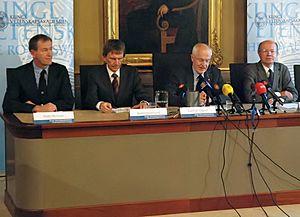Nobel Memorial Prize in Economic Sciences facts for kids
Quick facts for kids Sveriges Riksbank Prize in Economic Sciences in Memory of Alfred Nobel |
|
|---|---|
| Presented by | Royal Swedish Academy of Sciences |
| Location | Stockholm, Sweden |
| Reward | 11 million SEK (2023) |
| First awarded | 1969 |
| Currently held by | |
The Nobel Memorial Prize in Economic Sciences, officially called the Sveriges Riksbank Prize in Economic Sciences in Memory of Alfred Nobel, is a special award for economics. It is funded by Sveriges Riksbank, which is Sweden's central bank. The Nobel Foundation helps manage this important prize.
Even though it's not one of the five original Nobel Prizes created by Alfred Nobel in 1895, many people call it the Nobel Prize in Economics. It is managed and talked about alongside the other Nobel Prizes by the Nobel Foundation. The winners of this economics prize are chosen in a similar way to the other Nobel laureates. Their names are announced at the same time, and they receive their award at the Nobel Prize Award Ceremony.
The prize was started in 1968 by Sveriges Riksbank. They created it to celebrate the bank's 300th anniversary. The winners are chosen by the Royal Swedish Academy of Sciences. The very first prize was given in 1969 to Jan Tinbergen from the Netherlands and Ragnar Frisch from Norway. They won for creating and using special models to study how economies work.
Contents
How the Economics Prize Was Created and Funded
The Sveriges Riksbank gave money to the Nobel Foundation to create this prize. This money helps pay for the costs of running the award. It also provides the cash prize for the winners.
In 2022, the prize money for the economics award was 10 million Swedish kronor. This is the same amount of money given for the original Nobel Prizes. The bank also gives money each year to the Nobel Foundation to help with administrative costs.
How the Economics Prize Relates to the Nobel Prizes
It's important to know that the Prize in Economic Sciences was not part of Alfred Nobel's original will. He did not create it. However, the way winners are nominated, chosen, and given their awards is very similar to the original Nobel Prizes.
The winners are announced at the same time as the Nobel Prize winners. They also receive their awards at the same ceremony. The Royal Swedish Academy of Sciences gives out the prize. They follow the same rules as the original Nobel Prizes. These rules say the prize should go to those who "shall have conferred the greatest benefit on mankind."
How Winners Are Nominated and Chosen
The Royal Swedish Academy of Sciences is in charge of choosing the winners. This Academy also awards the Nobel Prizes in Physics and Chemistry.
Every September, a special committee for the Economics Prize sends invitations. They ask thousands of scientists, professors, and members of academies around the world to suggest candidates. Members of the Academy and past winners can also nominate people. All suggestions must be sent in before February 1.
The Prize Committee and experts then review all the suggestions. Before the end of September, the committee chooses the potential winners. If there is a tie, the chairman of the committee makes the final decision.
In mid-October, members of the Royal Swedish Academy of Sciences vote. They decide who will be the next winner or winners. Like the Nobel Prizes, no more than three people can share the prize in one year. The winners must be alive when the prize is announced in October. Also, information about who was nominated stays secret for 50 years.
Winners of the economics prize get a diploma, a gold medal, and a document for their money. They receive these from the King of Sweden. This happens at the annual Nobel Prize Award Ceremony in Stockholm on December 10. This date is the anniversary of Alfred Nobel's death.
Who Has Won the Prize
The first economics prize was given in 1969 to Ragnar Frisch and Jan Tinbergen. They won for their work on economic models. So far, three women have received this prize. They are Elinor Ostrom (2009), Esther Duflo (2019), and Claudia Goldin (2023). Claudia Goldin was the first woman to win the award by herself.
Awards to Social Scientists
In 1995, the prize was redefined. It became a prize for "social sciences." This meant that researchers in fields like political science, psychology, and sociology could also win.
For example, Herbert A. Simon, who studied political science, won in 1978. He won for his work on economics and how organizations make decisions. Elinor Ostrom, another political scientist, won in 2009. Daniel Kahneman, a psychology professor, won for his work in behavioral economics. This shows that the prize can go to people from different social science backgrounds.
See also
 In Spanish: Premio de Economía Conmemorativo de Alfred Nobel para niños
In Spanish: Premio de Economía Conmemorativo de Alfred Nobel para niños
- List of economics awards
- List of Nobel laureates by country
- List of prizes known as the Nobel of a field
- List of prizes named after people
- Mont Pelerin Society


